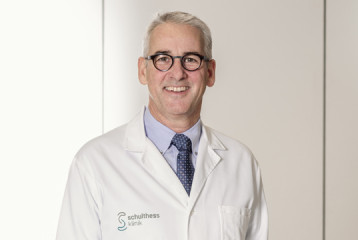Finding the best solution for patients with spinal curvature Research project
Spinal curvature is very common in adults and occurs in approximately 68% of people over the age of 60. Those affected are often restricted in their quality of life and suffer from pain and restricted mobility. The treatment options are very diverse. Choosing the most ideal treatment can significantly improve a patient's quality of life. To operate or not to operate? If so, using what method? These are just some of the questions being addressed by our current research project – always with the aim of finding the best treatment for each patient.
"Increasing numbers of people are affected by curvature of the spine, which often severely restricts their quality of life. Helping these people is what drives us every day."
Dr. med. Frank Kleinstück, Deputy Head of Spine Surgery, Orthopaedics and Neurosurgery and Principal Investigator of the European Spine Study Group (ESSG)
Multicentre study as part of the European Spine Study Group (ESSG)
Spinal curvatures are very common in adults and occur in approximately 68% of people over the age of 60. With the proportion of the world’s population over 60s almost doubling by 2050, spinal curvature is increasingly being recognised as a disease that can take on epidemic proportions and become a major concern of global health care systems. At the same time, the demands on quality of life are increasing. Some of the patients affected are severely restricted in their daily lives, suffering from pain and restricted movement, making it difficult for them to do even the simplest things.
The reasons for curvature of the spine, their manifestations and progression are very broad-ranging, as are the treatment options available to patients. Choosing the most ideal treatment can significantly improve a patient's quality of life. Which treatment best helps whom? To operate or not to operate? If so, using what method? What role do timing or co-morbidities play? What can improve the investigation? Such questions can only be answered on a scientific basis. The aim must always be to create an individual treatment plan for each patient.
Objective: scientific basis for the best solution
In 2010, a number of passionate spine surgeons dedicated themselves to helping such patients and promoting their quality of life by creating a scientific basis. The result was the founding of the European Spine Study Group (ESSG), of which Schulthess Klinik has also been part since 2012. To this day, Schulthess Klinik is still one of five member clinics. There are only two research groups of this kind in the entire world – one in the USA (ISSG) and one in Europe (ESSG). We work together to maintain the world’s leading prospective database on the treatment of these patients and develop ongoing research.
This joint research project has already resulted in more than 70 publications. Many of these studies have provided fundamental insights for the future of treatment and have been awarded an array of prestigious prizes. The next objectives are:
- To develop and improve prognostic tools: Even now, we are in a better position to predict what patients can expect from their surgery. These tools need to be expanded.
- To use automated X-ray analysis to process data more quickly and efficiently
- To expand the analysis to include biological factors: For example, what roles do the condition of bones, muscles, connective tissue or even genetic factors play?
- To improve movement analysis: Together with ETH, we are developing a model that will simulate the impact on the individual sections of the
spine.
How your donation helps
These studies are based on the collection and evaluation of comprehensive data from patients with this condition. The database now contains data from over 2,000 treated patients. 633 measurements are collected per patient in the first collection alone, a number that multiplies over the years. Measurements include clinical examination, patient surveys, radiological imaging, surgical data and much more. A special coordinator at Schulthess Klinik is responsible for the study of data collection and evaluation, which needs to be financed. She is also responsible for all administration, project coordination and communication with patients, doctors and study centres. The doctors involved in the research project are volunteering their time for this project.
Donate to research
Would you like to get involved in the future of medicine?
One of the main areas of activity of the Wilhelm Schulthess Foundation is the advancement of research, always with the aim of enabling patients to receive the best possible treatment. By donating to our research fund, you are directly supporting scientific training, research and development in the field of orthopaedics – a specific example being the “Finding the best solution for patients with spinal curvature" research project.
Find out more about how to donate:
Contact us
Would you like to know more about this project or other opportunities to support projects from the Research Fund or and Patient Assistance Fund ? We are looking forward to hearing from you.

